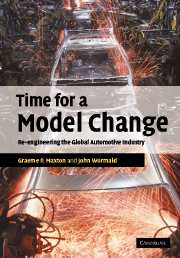Book contents
- Frontmatter
- Contents
- List of figures
- Foreword by G. Fredric Bolling
- Acknowledgements
- Glossary
- Introduction
- 1 From automania to maturity – in the main markets at least
- 2 The problems that can be fixed – dealing with noxious emissions, traffic accidents and congestion
- 3 The global resource challenges – energy and global warming
- 4 A global industry and the changing international order
- 5 The supplier industry – the catalyst for the profound changes to come?
- 6 The downstream sales and service sector
- 7 When the labels do not add up
- 8 Choosing a future for the automotive industry
- 9 Time for a model change
- Index
Introduction
Published online by Cambridge University Press: 22 September 2009
- Frontmatter
- Contents
- List of figures
- Foreword by G. Fredric Bolling
- Acknowledgements
- Glossary
- Introduction
- 1 From automania to maturity – in the main markets at least
- 2 The problems that can be fixed – dealing with noxious emissions, traffic accidents and congestion
- 3 The global resource challenges – energy and global warming
- 4 A global industry and the changing international order
- 5 The supplier industry – the catalyst for the profound changes to come?
- 6 The downstream sales and service sector
- 7 When the labels do not add up
- 8 Choosing a future for the automotive industry
- 9 Time for a model change
- Index
Summary
The world's automotive industry affects almost all of us in some way. It employs millions of people directly, tens of millions indirectly. Its products have transformed society, bringing undreamed-of levels of mobility, changing the ways we live and work. For much of the developed world, and increasingly for the developing world, it is a pillar industry, a flag of economic progress. Without an automotive industry it is impossible to develop an efficient steel business, a plastics industry or a glass sector – other central foundations of economic progress. The automotive industry has been a core industry, a unique economic phenomenon, which has dominated the twentieth century.
What can we expect of it in the twenty-first century? Not the same, for sure. The automotive industry now suffers from a series of structural schisms. It has become riddled with contradictions and economic discontinuities. For the capital markets and the finance sector it has lost a lot of its significance, as a result of ever declining profits and stagnant sales. The proliferation of products means that it has become hopelessly wasteful of economic resources. There is now a divided world of over-motorised countries like those in Europe, the US and Japan, and hungry aspirants almost everywhere else. Motorising these markets to the same extent is simply not possible soon. So there is a growth problem too.
- Type
- Chapter
- Information
- Time for a Model ChangeRe-engineering the Global Automotive Industry, pp. 1 - 2Publisher: Cambridge University PressPrint publication year: 2004



